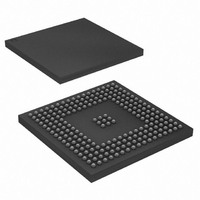AT91SAM9RL64-CU Atmel, AT91SAM9RL64-CU Datasheet - Page 757

AT91SAM9RL64-CU
Manufacturer Part Number
AT91SAM9RL64-CU
Description
IC ARM9 MCU 217-LFBGA
Manufacturer
Atmel
Series
AT91SAMr
Specifications of AT91SAM9RL64-CU
Core Processor
ARM9
Core Size
16/32-Bit
Speed
240MHz
Connectivity
EBI/EMI, I²C, MMC, SPI, SSC, UART/USART, USB
Peripherals
AC'97, LCD, POR, PWM, WDT
Number Of I /o
118
Program Memory Size
32KB (32K x 8)
Program Memory Type
ROM
Ram Size
72K x 8
Voltage - Supply (vcc/vdd)
1.08 V ~ 1.32 V
Data Converters
A/D 6x10b
Oscillator Type
Internal
Operating Temperature
-40°C ~ 85°C
Package / Case
217-LFBGA
Processor Series
AT91SAMx
Core
ARM926EJ-S
Data Bus Width
32 bit
Data Ram Size
64 KB
Interface Type
2-Wire, SPI, SSC, USART
Maximum Clock Frequency
240 MHz
Number Of Programmable I/os
118
Number Of Timers
4
Maximum Operating Temperature
+ 85 C
Mounting Style
SMD/SMT
3rd Party Development Tools
JTRACE-ARM-2M, MDK-ARM, RL-ARM, ULINK2
Development Tools By Supplier
AT91SAM-ICE, AT91-ISP
Minimum Operating Temperature
- 40 C
On-chip Adc
10 bit, 6 Channel
Controller Family/series
AT91SAM9xxx
No. Of I/o's
118
Ram Memory Size
64KB
Cpu Speed
240MHz
No. Of Timers
1
Rohs Compliant
Yes
Package
217LFBGA
Device Core
ARM926EJ-S
Family Name
91S
Maximum Speed
240 MHz
Operating Supply Voltage
1.8|3.3 V
For Use With
AT91SAM9RL-EK - KIT EVAL FOR AT91SAM9RLAT91SAM-ICE - EMULATOR FOR AT91 ARM7/ARM9
Lead Free Status / RoHS Status
Lead free / RoHS Compliant
Eeprom Size
-
Lead Free Status / Rohs Status
Lead free / RoHS Compliant
Available stocks
Company
Part Number
Manufacturer
Quantity
Price
Company:
Part Number:
AT91SAM9RL64-CU
Manufacturer:
ATMEL
Quantity:
16
Company:
Part Number:
AT91SAM9RL64-CU
Manufacturer:
ATMEL
Quantity:
255
Part Number:
AT91SAM9RL64-CU
Manufacturer:
ATMEGL
Quantity:
20 000
- Current page: 757 of 903
- Download datasheet (13Mb)
41.4.12.2
41.4.12.3
41.4.12.4
41.4.12.5
41.4.12.6
6289C–ATARM–28-May-09
Not Powered State
Entering Attached State
From Powered State to Default State (Reset)
From Default State to Address State (Address Assigned)
From Address State to Configured State (Device Configured)
Self powered devices can detect 5V VBUS using a PIO. When the device is not connected to a
host, device power consumption can be reduced by the DETACH bit in UDPHS_CTRL. Dis-
abling the transceiver is automatically done. HSDM, HSDP, FSDP and FSDP lines are tied to
GND pull-downs integrated in the hub downstream ports.
When no device is connected, the USB FSDP and FSDM signals are tied to GND by 15 KΩ pull-
downs integrated in the hub downstream ports. When a device is attached to an hub down-
stream port, the device connects a 1.5 KΩ pull-up on FSDP. The USB bus line goes into IDLE
state, FSDP is pulled-up by the device 1.5 KΩ resistor to 3.3V and FSDM is pulled-down by the
15 KΩ resistor to GND of the host.
After pull-up connection, the device enters the powered state. The transceiver remains disabled
until bus activity is detected.
In case of low power consumption need, the device can be stopped. When the device detects
the VBUS, the software must enable the USB transceiver by enabling the EN_UDPHS bit in
UDPHS_CTRL register.
The software can detach the pull-up by setting DETACH bit in UDPHS_CTRL register.
After its connection to a USB host, the USB device waits for an end-of-bus reset. The unmasked
flag ENDRESET is set in the UDPHS_IEN register and an interrupt is triggered.
Once the ENDRESET interrupt has been triggered, the device enters Default State. In this state,
the UDPHS software must:
In this state, the EN_UDPHS bit in UDPHS_CTRL register must be enabled.
After a Set Address standard device request, the USB host peripheral enters the address state.
Warning: before the device enters address state, it must achieve the Status IN transaction of
the control transfer, i.e., the UDPHS device sets its new address once the TX_COMPLT flag in
the UDPHS_EPTCTL[0] register has been received and cleared.
To move to address state, the driver software sets the DEV_ADDR field and the FADDR_EN
flag in the UDPHS_CTRL register.
Once a valid Set Configuration standard request has been received and acknowledged, the
device enables endpoints corresponding to the current configuration. This is done by setting the
BK_NUMBER, EPT_TYPE, EPT_DIR and EPT_SIZE fields in the UDPHS_EPTCFGx registers
and enabling them by setting the EPT_ENABL flag in the UDPHS_EPTCTLENBx registers, and,
optionally, enabling corresponding interrupts in the UDPHS_IEN register.
• Enable the default endpoint, setting the EPT_ENABL flag in the UDPHS_EPTCTLENB[0]
• Configure the Interrupt Mask Register which has been reset by the USB reset detection
• Enable the transceiver.
register and, optionally, enabling the interrupt for endpoint 0 by writing 1 in EPT_INT_0 of the
UDPHS_IEN register. The enumeration then begins by a control transfer.
AT91SAM9R64/RL64 Preliminary
757
Related parts for AT91SAM9RL64-CU
Image
Part Number
Description
Manufacturer
Datasheet
Request
R

Part Number:
Description:
MCU, MPU & DSP Development Tools KICKSTART KIT FOR AT91SAM9 PLUS
Manufacturer:
IAR Systems

Part Number:
Description:
DEV KIT FOR AVR/AVR32
Manufacturer:
Atmel
Datasheet:

Part Number:
Description:
INTERVAL AND WIPE/WASH WIPER CONTROL IC WITH DELAY
Manufacturer:
ATMEL Corporation
Datasheet:

Part Number:
Description:
Low-Voltage Voice-Switched IC for Hands-Free Operation
Manufacturer:
ATMEL Corporation
Datasheet:

Part Number:
Description:
MONOLITHIC INTEGRATED FEATUREPHONE CIRCUIT
Manufacturer:
ATMEL Corporation
Datasheet:

Part Number:
Description:
AM-FM Receiver IC U4255BM-M
Manufacturer:
ATMEL Corporation
Datasheet:

Part Number:
Description:
Monolithic Integrated Feature Phone Circuit
Manufacturer:
ATMEL Corporation
Datasheet:

Part Number:
Description:
Multistandard Video-IF and Quasi Parallel Sound Processing
Manufacturer:
ATMEL Corporation
Datasheet:

Part Number:
Description:
High-performance EE PLD
Manufacturer:
ATMEL Corporation
Datasheet:

Part Number:
Description:
8-bit Flash Microcontroller
Manufacturer:
ATMEL Corporation
Datasheet:

Part Number:
Description:
2-Wire Serial EEPROM
Manufacturer:
ATMEL Corporation
Datasheet:











